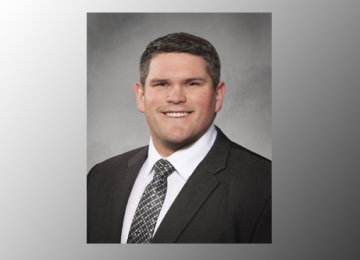
Desjarlais recently shared his thoughts on the new role as vice-president and his experiences as an Indigenous engineer.

Recently John Desjarlais was voted in as APEGS vice-president, making him one of the few Indigenous engineers in such a role for a Canadian engineering regulator. An active member both of the Saskatchewan and the Canadian engineering communities, John recently shared some of his experiences and thoughts on this new role.
Please tell us a bit about yourself and where you are from.
I am Cree-Metis from Cumberland House, in Northern Saskatchewan. I lived almost exclusively in the community, which is in Treaty 5. It’s relatively isolated and where my mother was raised. My father was from the Qu’Appelle area, in treaty 4, a region I am also proud to have a connection and continued close ties with. My father ended up settling with his new family in Cumberland House where they both live today. I grew up immersed in the rich culture and proud history of the area, understanding how Indigenous people were instrumental in ensuring the success of the development of Western Canada through the fur trade and resource economy.
You wear many volunteers hats, among them councillor for APEGS and co-chair for the Canadian Indigenous Advisory Council to the American Indian Science and Engineering Society (AISES). How do you see these different roles relating to one another and your current journey?
The roles are unique but certainly complementary, which is something I consider when pursuing any opportunity. I first ask myself if opportunities line up with my values, and the role of councillor for APEGS, and my roles with the Canadian STEM community, certainly do. I am fortunate in my own reconciliation journey and the many opportunities that my STEM education and support have provided me. My journey also gave me perspective and appreciation for the challenges that many, including those in the Indigenous community, could face in accessing similar opportunities. I have a responsibility to give back, removing barriers for others, and this is something I make a condition in my professional pursuits.
What excites you most about this new position with APEGS and what do you hope to accomplish?
I am excited to deepen my involvement with the organization, offer my perspective, and influence how we, as a regulator, can best serve the public and regulate our members. I am passionate about good governance, and the processes that support effective decision making and stronger alignment of organizations. The association is also undergoing a governance review, and I am intimately involved in this project, which was initiated as a continual improvement process and grew from the desire to ensure we are always achieving the objectives of the association. I am also passionate that our organization is accessible and that it delivers professional duties in the interest of public safety and the environment. Through this, I am invested in ensuring that the profession is also representative of our public, that it is inclusive, and that it represents the interest of the public, which includes all interest groups.
What have been some of your challenges so far? What are the things you are most proud of?
In terms of challenges, they have been minor. The organization is very professional, well established, and operates with impressive organization and structure. I have been able to share my perspective and experience in communication and as an Indigenous professional, which I feel has been welcomed. My proudest achievement so far was using the support and encouragement of APEGS to facilitate the development of CIAC and .caISES. I believe that if I didn’t have the support and resources, along with the opportunity to meet like minds (Matthew Dunn, and the rest of the CIAC crew), these developments would have been significantly delayed or would not exist at all in the shape they are in now.
What do you think is the role of engineering regulators in supporting truth and reconciliation efforts? In supporting equity, diversity, and inclusion work?
I feel that we have an important role to play in truth and reconciliation. Our members are part of a variety of sectors, directly addressed in the reports, like education and business. As professionals, we have a substantive equality obligation to address barriers to entry into our profession. If we know there are barriers regarding gender, disability, visible minority, or Indigenous inclusion, we have an obligation to address these and ensure our profession is accessible and equitable.
We engage the public as professionals in all aspects of our work (e.g. design, consultation, project management). We need to ensure we engage in this work not by treating all groups interest groups “equal” but by striving for true equality and equitable participation. We do this by understanding that certain interest groups that make up the public are marginalized in different ways, and by ensuring that our work outcomes do not marginalize these interest groups. Outcomes truly need to reflect the best interests of public safety and protection of the environment.
What would you like to share with Indigenous youth and young people in general, who are considering a career in engineering?
I strongly encourage youth to consider a career in engineering or geoscience, or any profession—especially in STEM, where opportunities are immense, especially for underrepresented groups like mine: Indigenous peoples. My opportunities are a direct reflection of my choice in engineering as a profession, and I am on an incredible journey I wish others would experience as well. The path isn’t easy, but there is a growing, thriving community for those interested, and support is growing every day to help young people succeed. I know that, because there is a growing number of people like me, helping to ensure this community grows and supporting one another in their own success.


